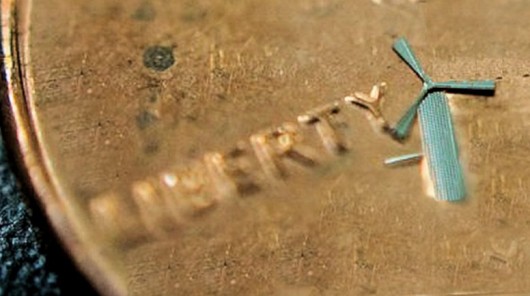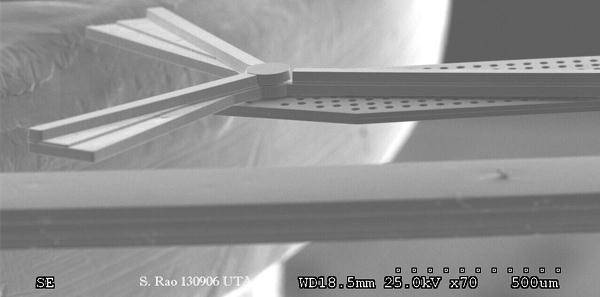Kyle Maxey
posted on January 15, 2014 |
| 2607 views
 Everyone’s been there. You’re in the middle of an important call and
all of a sudden your cellphone urgently chimes in your ear, alerting you that
its battery is about to kick the bucket. Although battery life has long been the
bane of mobile existence, a new microelectromechanical systems (MEMS) technology
could solve the ever-present problem of recharging your mobile device.
Everyone’s been there. You’re in the middle of an important call and
all of a sudden your cellphone urgently chimes in your ear, alerting you that
its battery is about to kick the bucket. Although battery life has long been the
bane of mobile existence, a new microelectromechanical systems (MEMS) technology
could solve the ever-present problem of recharging your mobile device.
Measuring in at only 1.8 mm at its widest point, the key to possibly endless
energy is a micro-scale windmill so small a single grain of rice could support
ten of the tiny devices. Created by research associate Smitha Rao and professor
J.-C. Chiao, the Lilliputian windmill was designed by blending origami folding
with conventional semi-conductor layout technique. By uniting the two processes,
the University of Texas at Arlington (UTA) team was able to create complex,
self-assembling, 3-dimensional mechanical structures from 2-dimensional metal
plates.
Constructed using a nickel-alloy, Rao and Chiao’s windmill has eschewed the
main problem facing MEMS machines—their fragility. After successful structural
tests of their micro-windmills last September, the UTA team is confident that
their choice of material will make their devices strong enough to handle any
industry use.
 For the time being, however, the team is focused on integrating the
windmill with portable electronics. “Imagine that they can be cheaply made on
the surfaces of portable electronics,” Chiao said, “[S]o you can place
them on a sleeve for your smart phone. When the phone is out of battery power,
all you need to do is to put on the sleeve, wave the phone in the air for a few
minutes and you can use the phone again.”
For the time being, however, the team is focused on integrating the
windmill with portable electronics. “Imagine that they can be cheaply made on
the surfaces of portable electronics,” Chiao said, “[S]o you can place
them on a sleeve for your smart phone. When the phone is out of battery power,
all you need to do is to put on the sleeve, wave the phone in the air for a few
minutes and you can use the phone again.”
Aside from recharging our cellphones and tablets, Chiao also sees a future
where MEMS windmills could be embedded into flat panels that line the exterior
of houses, generating power for interior lighting or security systems.
Given that Roa and Chaio’s windmills are already piquing the interest of
industry, it might not be long before we see similar devices showing up in our
electronics. For with these new systems in place, prematurely ended calls and
the constant search for an outlet might be a thing of the past for good.
Images and Video Courtesy of UT Arlington